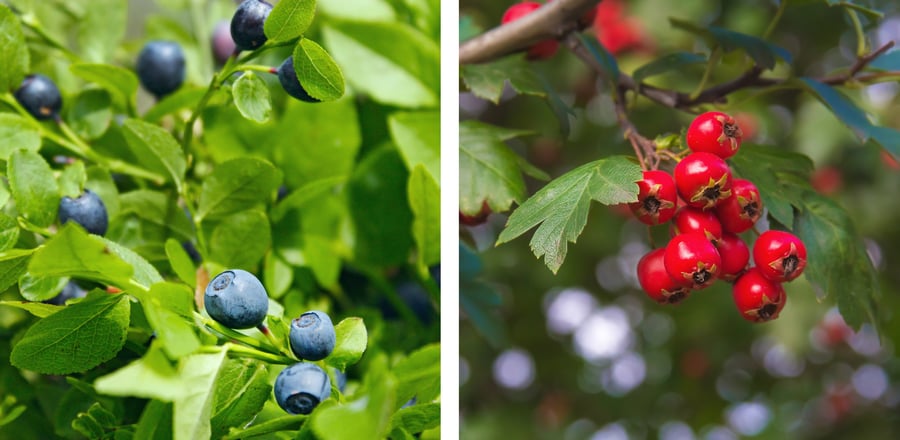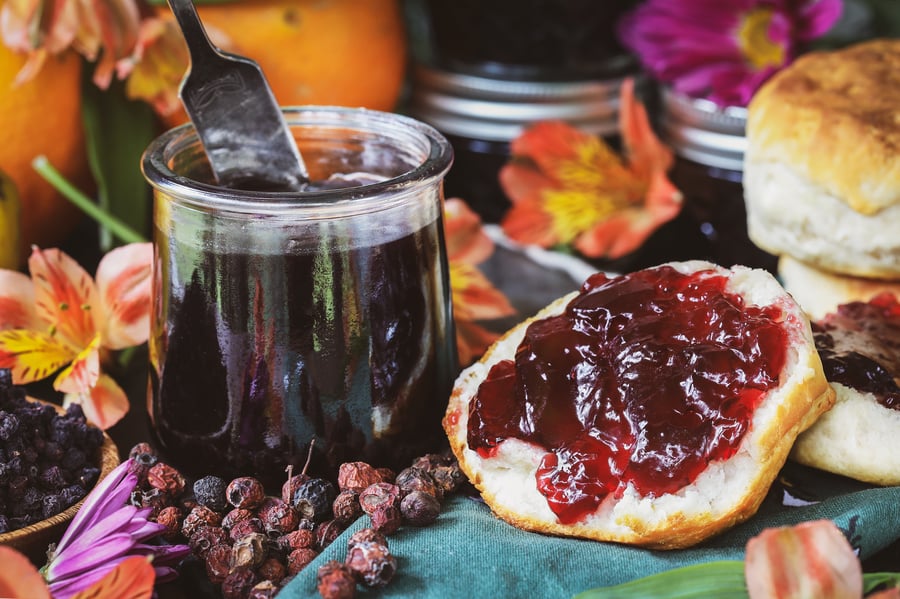Right around Spring Equinox, I start to take inventory of what is in my apothecary, what needs to be used in the next few months, and what needs to be replaced now. This timing is serendipitous because as winter comes to a close and summer’s nutritious fresh berries are still months away, I start to crave the bright flavor and nutritious zing of freshly made superfood jelly. Hence, the end of March is my annual dried berries jelly-making time. This year, I was excited to find that my dried hawthorn berries and bilberries are on the 2024 refill list. These two superfood berries, particularly in combination, are perfect for early spring jelly-making and result in one of my all-time favorite jellies. One batch carries my family happily into summer.
Bilberries (Vaccinium myrtillusare) are related to blueberries, cranberries, and huckleberries. Native to Europe and the British Isles, they are sometimes called European blueberries. Bilberries are packed with nutrition and have a long history of traditional use. Their wonderfully purple color comes from natural anthocyanosides, and they contain phenolic acid that helps maintain cell integrity and fight free radicals.*
Hawthorn Berries (Crataegus monogyna) are a member of the rose family and have been used for centuries in culinary and health-supporting recipes. Western herbalists love hawthorn leaves, flowers, and berries for their affinity for the heart and have long used hawthorn to support healthy cardiovascular function and uplift the heart for emotional well-being.* Hawthorn is also revered for ceremonial and spiritual purposes.
Hawthorn Berry and Bilberry Jelly Recipe
Makes about 6 half-pint jars of jelly.
Ingredients
- About 3 oz. (by weight) fresh, unpeeled organic orange (I used 1/2 a medium orange)
- 1/2 cup dried organic bilberries
- 1/2 cup dried organic hawthorn berries
- 5 cups water + more if necessary
- 3 1/2 cups organic sugar
- 1/2 cup lemon juice
- 1.75-oz. package of dry pectin
- 1/4 tsp. butter (optional)
Directions
- Cut orange with peel into several pieces. Combine orange chunks with bilberries, hawthorn berries, and water in a stainless steel or other non-reactive pot (not cast iron or aluminum).
- Cover pot and bring to a boil over medium heat. Lower heat to simmer for 10 minutes. Stir, re-cover pot, and simmer for another 5 minutes, until very soft.
- Mash mixture a bit with a potato masher to break up orange pieces. Cover again and set aside to steep for 30 minutes.
- Strain through cheesecloth or a jelly bag, using a rubber spatula to turn the pulp as necessary to encourage draining. Juice may thicken as it cools, so may take 15 minutes or more to fully drain. Squeeze to get all the juice you can. You ultimately want 3 cups of juice. If necessary, put cooked pulp back in the pot, pour in 1 cup water, cover, and bring back to a simmer for 10 minutes.
- Remove from heat and set aside to steep for another 15 minutes, then strain again.
- Meanwhile, thoroughly wash 6 half-pint jars and canning lids in hot, soapy water and rinse well. Put jars on a baking pan in the oven at 250° F to sterilize.
- Place lids on a towel rubber-side up and set aside with canning rings.
- Measure out sugar. Set aside.
- Combine 3 cups hawthorn/bilberry juice with lemon juice and the box of pectin in a pot. Bring to a boil over medium-high heat, stirring regularly, to dissolve pectin.
- Add pre-measured sugar. Stir to dissolve.
- When dissolved, add optional bit of butter to keep the mixture from foaming too much.
- Stirring constantly, bring to a full "hard" boil (one you cannot stir down), and boil at that rate for exactly one minute.
- Remove from heat, skim off any foam on top.
- Ladle into hot jars, leaving 1/2 inch room at the top. Wipe rims with clean damp cloth to ensure a good seal.
- If not canning, let jelly cool in open jars to room temperature, then place on lids and rings and put in the refrigerator overnight before using. Refrigerated, un-canned jelly will be shelf-stable for up to three weeks.
- If canning, put on lids and rings.
- Water bath can for 10 minutes in accordance with the USDA recommendations for your altitude.
- Turn off heat, remove lid from canner, and prepare a towel on the counter where jars can sit undisturbed for 24 hours. Remove jars from canner and put on towel.
- The next day, check each jar to ensure proper seal. Unsealed jars should be refrigerated and used within three weeks.
- When opened, canned jelly will keep for up to 6 months in the refrigerator.
Pro Tips
- If you have never canned before, please work with an experienced canner or check with your local extension service to ensure you are following all the safety precautions before you start.
- You may can jelly in 4-, 8-, or 12-oz. jars. Processing time is the same for all sizes. Don’t increase jar size beyond 12 oz.
*These statements have not been evaluated by the Food and Drug Administration. These products are not intended to diagnose, treat, cure, or prevent any disease. We recommend that you consult with a qualified healthcare practitioner before using herbal products, particularly if you are pregnant, nursing, or on any medications. For educational purposes only.
Want another superfood jelly recipe?
Try This Homemade Rosehip Jelly Using Dried Rosehips + Vintage Thumbprint Cookie Recipe
You may also enjoy:
- Classic Rosehip Jam (with Canning Recipe)
- Hibiscus Flower Hot Pepper Jelly with Homemade Pectin
- Bilberry and Hawthorn Berry Syrup













